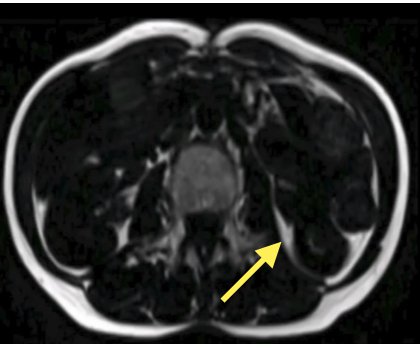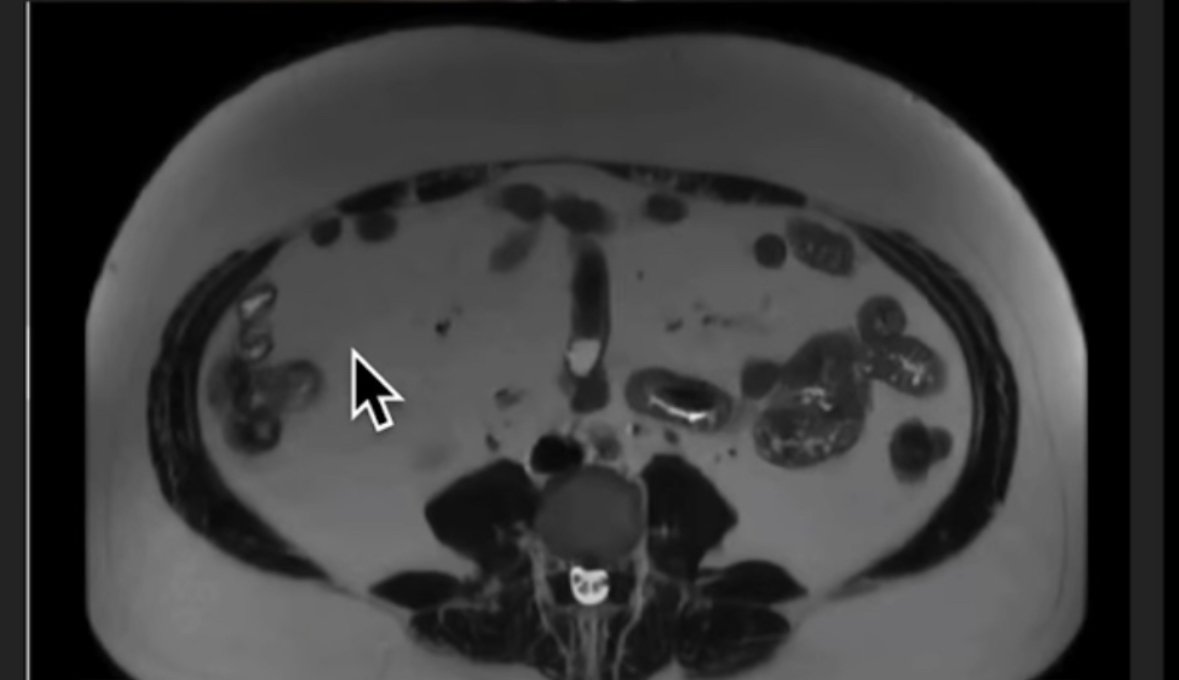PART I
VISCERAL FAT: HIDDEN DANGER
WHAT IS VISCERAL FAT AND WHY IS IT IMPORTANT?
Visceral fat refers to an abnormal accumulation of fat deep within the abdominal cavity, surrounding internal organs such as the liver, pancreas, kidneys and intestines.
The amount of visceral fat present has emerged as one of the strongest predictors of disease and death. It has extensive repercussions throughout the body, exerting profoundly adverse effects on every organ.
The scans below illustrate the contrast between a healthy amount of visceral fat and pronounced visceral fat accumulation. The first scan obtained from radiologist Dr. Ana Rosa MD, PhD shows an abdomen with very little visceral fat present. The visceral fat is shown as small white collections around the organs within the abdomen in this MRI image.
Scan courtesy of Dr. Ana Rosa MD, PhD. The arrow points to visceral fat.
The second scan, obtained from Dr. Sean Omara, an expert in visceral fat management, is an example of a large amount of visceral fat. The arrow points to the “sea” of white visceral fat surrounding, and almost strangling the internal organs.
Scan courtesy of Dr. Sean Omara MD, JD. The arrow is within the extensive visceral fat.
The good news is that visceral fat can be addressed and reversed.
FAT TYPES AND LOCATIONS
Body fat can have very harmful or beneficial health effects depending on the type of fat and where it’s located. Fat stored just underneath the skin (superficial subcutaneous fat) actively generates a health-promoting molecule known as adiponectin. Babies have large amounts of this healthy fat. A small amount of superficial subcutaneous fat protects the heart and other organs in adults so it’s not a good idea to eliminate this layer as observed in some bodybuilders, extreme diets or starvation.
The same factors that lead to increasing amounts of visceral fat also lead to fat accumulating in the deep subcutaneous compartment (for example love handles), around the heart (which secretes molecules that damage the heart) and skeletal muscles (can lead to poor mobility at an early age).
VISCERAL FAT MAY BE HIDDEN
It’s important to understand that a significant amount of visceral fat can be present even in individuals with a normal body weight or a BMI within the normal range - the so called TOFI body type (thin on the outside and fat on the inside). These individuals are also at high risk despite their outward appearance.
The scan below shows an individual who has a fairly flat abdomen without large amounts of subcutaneous fat. However there is an extensive collection of dangerous visceral fat (TOFI). This underlines the importance of accurately assessing the amount of visceral fat present as it may not be at all obvious based on external inspection.
Scan courtesy of Dr. Ana Rosa MD, PhD
Conversely, a small minority of people have a significant amount of subcutaneous fat and very little visceral fat. In this case the level of risk depends on where the subcutaneous fat is located. Fat in the superficial subcutaneous compartment is actually protective but deep subcutaneous fat poses similar risks to visceral fat.
VISCERAL FAT HAS SEVERE LONG TERM CONSEQUENCES
Far from an inert storage depot of excess fat, visceral adipose tissue actively secretes a number of damaging chemicals into the bloodstream leading to chronic low-grade inflammation and insulin resistance.
Insulin resistance and chronic low grade inflammation not only lead to type 2 diabetes but are also well recognized drivers of the top causes of chronic illness and death including heart disease, non-alcoholic fatty liver disease, Alzheimer’s disease and cancer.
In addition there are some common health challenges which have a surprising, yet well-documented connection to visceral fat. These include erectile dysfunction, polycystic ovarian syndrome and poor CoVID-19 outcomes.
VISCERAL FAT AND TYPE 2 DIABETES
A consistently strong association has been demonstrated between increased visceral fat, insulin resistance and the development of type 2 diabetes.
Insulin is the most important hormone responsible for regulating blood sugar levels. When cells become resistant to its effects, glucose accumulates in the bloodstream, leading to type 2 diabetes. Inflammatory substances and hormones released by visceral fat significantly promote insulin resistance by disrupting insulin signaling pathways.
Visceral fat also releases free fatty acids, thereby promoting the accumulation of triglycerides and dyslipidemia (disordered cholesterol metabolism). This is another key factor in the development of type 2 diabetes because this also leads to insulin resistance.
CARDIOVASCULAR DISEASE
Scientific studies have firmly established the connection between visceral fat and cardiovascular disease, encompassing conditions such as coronary artery disease, stroke, and heart failure.
Research has shown that this chronic low-grade inflammation, orchestrated by visceral fat, plays a pivotal role in the atherosclerotic process, damaging the lining of the blood vessels and promoting the buildup of plaque within arteries.
Moreover, visceral fat is also associated with cholesterol imbalances, insulin resistance, and elevated blood pressure, all of which are well-established risk factors for cardiovascular disease.
NON-ALCOHOLIC FATTY LIVER DISEASE
Research suggests that visceral adipose tissue plays a crucial role in the development and progression of NAFLD. Significant factors include insulin resistance, release of free fatty acids causing fat to accumulate in the liver and chronic low grade inflammation which all damage the liver cells and increase the long term risk of cirrhosis and liver cancer.
ALZHEIMER’S DISEASE
Emerging evidence suggests a strong association between visceral fat and brain-related disorders, including neurodegenerative diseases like Alzheimer's and vascular cognitive impairment. The mechanisms linking visceral fat to these conditions are multifaceted, involving systemic inflammation, insulin resistance, and vascular dysfunction.
Alzheimer’s is often referred to as “type 3 diabetes” due to the now recognized role of insulin resistance in causing damage to brain tissue. Adipokines released from visceral fat interferes with insulin signaling pathways in the brain leading to impaired function.
Moreover, inflammation triggered by visceral fat may also contribute to the breakdown of the blood-brain barrier, allowing harmful substances to enter the brain - adding insult to injury.
CANCER
While obesity has long been associated with various health risks, recent scientific research has also illuminated the specific role of visceral fat in cancer development. It is now evident that visceral fat is a key contributor to the increased risk of the most common cancers including breast, prostate, colon and other cancers.
Chronic inflammation triggered by visceral fat promotes DNA damage, uncontrolled propagation of new blood vessels and reduced apoptosis (cycling of old, damaged cells) – all factors contributing to the development of cancer. This inflammatory micro-environment has been implicated in various stages of cancer development, including the initial development of cancer, cancer growth and spread to distant organs.
Beyond inflammation, visceral fat also influences cancer risk through alterations in hormone levels. Hormones such as insulin and estrogen, which are modulated by visceral fat, have been implicated in the development of hormone-sensitive cancers such as breast and endometrial cancer.
ERECTILE DYSFUNCTION
Visceral fat can be an important underlying cause of erectile dysfunction (ED) even in individuals who are not overtly obese. It’s not only the total amount of fat present but where this fat is located that’s important.
Insulin resistance, caused by increased visceral fat appears to play a central role in the development of ED. Besides its impact on glucose metabolism, insulin regulates blood vessel dilation by temporarily increasing nitric oxide. However, a lack of response to insulin in the vessel lining can blunt this effect, leading to impaired blood flow and ED.
Visceral fat also triggers chronic low-grade inflammation and plaque buildup in the vessel wall, leading to further reduction in blood flow and even greater insulin resistance - a vicious cycle.
Despite the distressing implications, there's hope as, in many cases, visceral fat and ED can be reversed. Addressing the root cause of ED is preferable to merely increasing blood flow temporarily with drugs, given that the damage due to visceral fat occurs throughout the body. Additionally, the efficacy of ED drugs diminishes over time as the condition progresses.
PCOS
Polycystic ovarian syndrome (PCOS) is a leading cause of infertility and metabolic syndrome.
It is widely appreciated that weight gain and insulin resistance are consequences of PCOS. What is becoming more apparent is that PCOS may itself be caused by the high insulin levels seen with visceral fat accumulation.
High insulin levels result in androgen dominance and impaired maturation of eggs in the ovaries. This results in the development of multiple ovarian cysts, reduced fertility and other hormonal issues.
Nevertheless, establishing a causal relationship between visceral fat and PCOS is a reason for hope in terms of addressing this frustrating condition.
COVID-19
It’s widely accepted that obesity leads to more severe CoVID-19 infections. However emerging data indicates that this link is more specifically due to high levels of visceral fat than total body fat. This means that an individual with a normal BMI but high visceral fat will be similarly at risk. This is why it’s important to accurately assess the amount of visceral fat present regardless of total body weight or BMI. If elevated, reducing it is a high priority.
POOR MOBILITY
Accumulation of fat around the organs of the abdomen has several knock on effects including accumulation of fat in the skeletal muscles - so called “marbling” of the muscles. This change weakens the muscles and can result in reduced muscle strength and mobility at a younger age.
The scan below shows fat infiltration of the thigh muscles. This can lead to difficulty getting up from a seated position, poor mobilty and a significantly higher risk of falls.
Scan courtesy of Dr. Sean Omara. Arrow points to fatty infiltration of the thigh muscles
The GOOD NEWS
Despite the profound health burden caused by visceral fat accumulation, the awesome news is that visceral fat can be reduced and these deleterious effects may be reversed by doing so. The earlier you start, the better!
How to Measure Visceral Fat
The amount of visceral fat can be estimated by simple measurements like waist size and waist to hip ratio. However these approaches may miss significant amounts of visceral fat. DEXA scans are more accurate but these ony provide an estimate of the amount of visceral fat present.
MRI and CT are the most precise ways of assessing - and visualizing - the quantity visceral fat present. The advantage of MRI is lack of radiation exposure which makes it safer for repeat testing to track progress over time. However, the cost of MRI is a major drawback. To improve accessibility, Luminnova Health is partnering with Open MRI to make this gold standard assessment more affordable and available to a wider group of people.
Strategies to Reduce Visceral Fat
The following strategies have been demonstrated to be effective in reducing visceral fat:
Eat whole foods rich in fiber, polyphenols and omega-3 fatty acids
Optimize your gut microbiome with fermented foods, probiotics and post-biotics
Prioritize resistance exercises and short bursts of vigorous activity if you are able to do so
Check and optimize your vitamin D level
Consider adding strategic weight management supplements to a good foundation of diet and healthy level of exercise
Avoid ultra-processed foods (pre-packaged foods with multiple unrecognizable ingredients)
Avoid refined carbohydrates and sugars (sweet drinks, bottled fruit juices, cakes, cookies, muffins, white rice, white bread etc.)
Minimize alcohol consumption
Minimize intake of high omega-6 seed oils
Get adequate restorative sleep
Reduce stress or employ effective coping mechanisms if unavoidable
Beware of excessive endurance training (long distance running/jogging)
Consider time restricted eating (definitely avoid late night snacks)
All of the above recommendations should be based on medical advice and considered in the context of your current medical status. These strategies will be discussed in greater detail in the second part of this series.
TAKE ACTION
Considering the widespread and profound implications of visceral fat accumulation it is important to act NOW!
The initial focus should be on accurately assessing the amount of visceral fat, implementing measures to reduce it if necessary, and monitoring progress over time. This is too important to leave to guess work.
If you would like to have an MRI scan carried out as the first step in this journey, contact Luminnova Health for more information.





